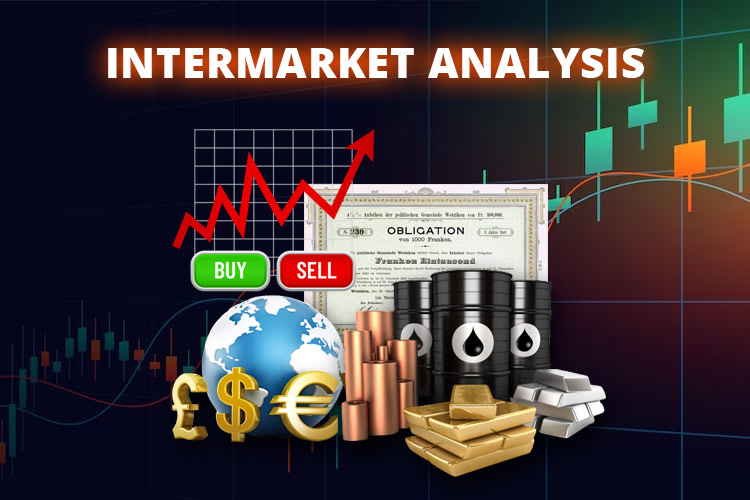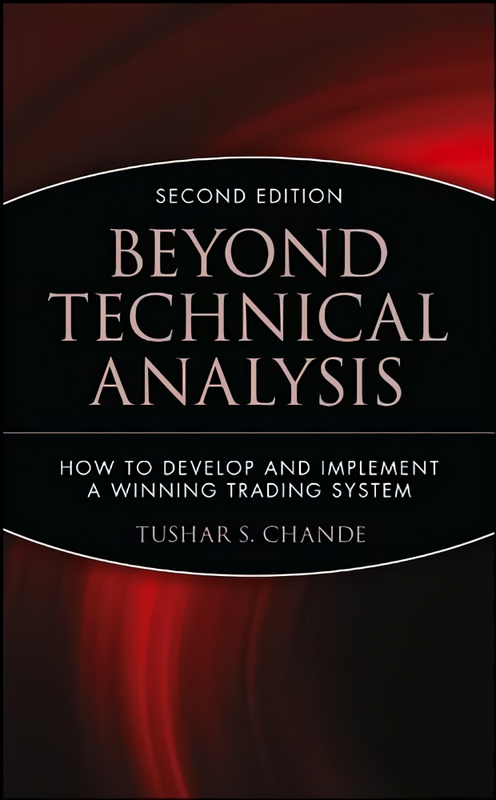Intermarket analysis is a method of analyzing prices by examining the interaction of several financial assets such as forex, stocks, bonds, and commodities.
 The forex market is part of the global economy that is influenced by various types of financial markets. In this case, the intermarket analysis method can help traders optimize profits and reduce risks due to the other market's impact on the forex market.
The forex market is part of the global economy that is influenced by various types of financial markets. In this case, the intermarket analysis method can help traders optimize profits and reduce risks due to the other market's impact on the forex market.
By its definition, intermarket analysis is a trading analysis based on the interaction of various types of financial assets on forex. These financial assets include stocks, bonds, and commodities.
In this regard, several aspects need to be understood when analyzing the intermarket:
- There is a positive correlation between global stock markets.
- There is a positive correlation between stock markets, bonds, and the currency exchange rate of a country.
- The gap between the two countries yields affects the currency exchange rate.
- If gold rises in price, the USD tends to be weaker.
- The movement of the USD affects crude oil prices.
How can these aspects be used as a reference in intermarket analysis? Let's take a look at the explanation below.
Intermarket Analysis Basics
Here are how the other market influences the forex market that forms the baseline of the intermarket analysis method:
- Stocks: In normal conditions, if the stock index of a country strengthens, the value of the country's currency also strengthens, and vice versa.
- Bonds: Bond prices and bond yields are used to gauge the level of interest rates in a country.
- Major global commodities: Global commodity prices are used to determine the inflation rate as well as supply and demand in import-exporting countries.
Forex and Stocks
The intermarket analysis model often begins with the stock price index. The stock market serves as the primary reference for financial markets, while the stock price index represents the prices of blue-chip stocks in a country.
When buying a country's stocks, you'll need to use that country's currency, right? For example, if you want to invest in Japanese blue chips, you have to exchange your Dollar for Japanese Yen.
As a result, the demand for Japanese Yen will increase. If the demand increases, the exchange rate will rise. Conversely, selling US Dollar currency increases its supply, so the exchange rate decreases.
Intermarket analysis of forex and stocks is based on the premise that:
If the prospects of a country's stock market are good, then the investor trust in that country rises, resulting in a significant influx of funds into the country and a strengthening of its currency exchange rate.
If the stock market starts to fall, then investor trust will drop, leading investors to move their wealth into the currencies of other countries with good growth prospects. As a result, the country's currency will decline in value.
As a forex trader, it is essential to monitor the conditions of major markets such as the US, UK, Japan, and China. Money flows will occur from countries with weakening stock market indices to countries with strengthening stock market indices. Therefore, if you buy the currency of a country with a favorable stock market outlook and sell the currency of a country with a poor stock market outlook, you have the potential to make substantial profits.
However, it is important to note that the aforementioned conditions were only applicable when the global economy is in a normal state, meaning there is no crisis or global recession. If the global economy is in crisis, the opposite situation may occur. For example, during the 2007-2009 global economic recession, the Nikkei and JPY stock price indices, which were initially negatively correlated, became positively correlated.
It is also important to remember that whenever there is turmoil in financial markets, the stock market is typically the first to be affected. Other markets such as bonds and forex will follow later. Stock markets around the world generally move in the same direction (positively correlated). So, if there is a global economic crisis, the prices of stocks in different countries around the world will fall.
In intermarket analysis, there are several important global stock price indexes. Some of these stock price indices include:
- Dow Jones - US
The Dow Jones stock index is a leading indicator representing 30 giant companies in the US such as McDonald's, Pfizer, and AT&T. The Dow Jones stock index is always referenced by investors around the world and is the most important indicator of market sentiment. It is also sensitive to changes in the global political and economic climate. - S&P 500 - US
After the Dow Jones, the S&P 500 is the most widely traded stock index in the US. The S&P 500 tracks the stock prices of 500 major US companies. Currently, the prestige of the S&P 500 is quite high and is used as a reference by fund managers and some US financial institutions. - NASDAQ - US
NASDAQ is a stock index that includes 3700 stock prices of US companies, especially technology-based companies. It is the third most important index after the Dow Jones and the S&P 500. - Nikkei - Japan
The prestige of the Nikkei in Japan is nearly on the same level as the Dow Jones in the US. This stock price index includes an average of 225 major companies in Japan such as Toyota, Japan Airlines, and Fuji Film. - DAX - Germany
The DAX covers the prices of blue chip stocks from 30 major German companies, such as Deutsche Bank, BMW, etc., traded on the Frankfurt Stock Exchange.
In addition to the above indices, there are more stock price indices that many investors pay attention to. For example, the Dow Jones Stock 50 in the Euro area, the FTSE in the UK, and the Hang Seng in Hong Kong.
Forex and Bonds
The bond market is one of the core parts of the global financial market system, so it is also considered by forex traders in intermarket analysis. A Bond is a document that shows that the investor has agreed to lend a certain amount of funds to the government of a country (for government bonds) or a legal entity (for corporate bonds).
A bond's yield can fluctuate as it depends on changes in the central bank's interest rate. If the interest rate rises, the bond yield will also rise, and vice versa. Central bank interest rates reflect the inflation rate. So, this increase will cause the currency exchange rate to strengthen.
For carry traders, the difference or spread between two countries' bond yields can become a golden opportunity. Therefore, you can predict the direction of movement of forex pairs by observing the spread and changes in interest rates. When the bond yield spread between two countries widens, the currency with the higher bond yield will strengthen against the currency with the lower bond yield.
Forex and Commodities
The major global commodities that have the most influence on currency exchange rates and serve as important indicators in intermarket analysis are gold and crude oil. The correlation between forex and gold can be explained as follows:
- Traditionally, when the global economy is growing, investors tend to buy US Dollars and sell gold, and vice versa.
- The Australian Dollar (AUD) is the currency that has the highest correlation with the price of gold worldwide. Historically, AUD/USD has a positive correlation of 80 percent with gold.
- Another forex pair that correlates with gold is USD/CHF (US Dollar vs. Swiss Franc). The reason is that 25 percent of Swiss Francs in circulation are backed by the country's gold reserves. Therefore, the Swiss Franc is positively correlated to gold prices.
Meanwhile, crude oil, also known as "black gold", is considered influential because the world's industrialized countries are still basically dependent on oil. The correlation goes like this:
- The global crude oil price is pegged in US Dollars, so fluctuations in the value of the US Dollar will directly affect the global oil price.
- The forex pair that is most correlated with world crude oil prices is USD/CAD. If the price of crude oil rises, the CAD will rise or USD/CAD will fall, and vice versa.
Summaries
Based on the explanation of intermarket analysis between forex and the world's major stocks, bonds, and commodities, it can be concluded that the most important aspects discussed in the previous section have this explanation:
- There is a positive correlation between the world's stock markets: When the Dow Jones index goes down, the Nikkei index is likely to go down as well. On the other hand, a country's stock price index and currency exchange rate are also positively correlated. When the Nikkei index (Japan) falls, the USD/JPY weakens or the JPY strengthens, and vice versa.
- There is a positive correlation between the stock market, bonds, and a country's currency exchange rate: A rise in the stock price index and bond yields signals a high return that will attract investors, thus increasing demand for the local currency.
- A widening of the bond yield spread between two countries affects the exchange rate: If the bond yield spread between two countries widens, the currency of the country with high bond yields will strengthen against the currency of the country with low bond yields.
- If gold prices rise, the USD tends to weaken: AUD/USD, NZD/USD, and EUR/USD rise, while USD/CHF falls.
- The movement of the USD affects the price of crude oil: If global crude oil prices rise, USD/CAD falls.
The relationships in the intermarket analysis mentioned above will show up in long-term price movements. So, intermarket analysis can be an additional consideration when determining market bias. Keep in mind, that neither positive nor negative correlations in intermarket analysis are absolute. This means that they can change depending on the current state of the world economy.

 Dedicated FREE FOREX VPS
Dedicated FREE FOREX VPS Free FOREX Virtual Private Server
Free FOREX Virtual Private Server MT4 Demo Contest, Get $500
MT4 Demo Contest, Get $500 Sign Up for an Account, Claim 60% Deposit Bonus
Sign Up for an Account, Claim 60% Deposit Bonus Free MT4/MT5 VPS 2024
Free MT4/MT5 VPS 2024 Send E-mail and Get Free Merchandise
Send E-mail and Get Free Merchandise $1K Refer a Friend Bonus for Pepperstone Pro clients
$1K Refer a Friend Bonus for Pepperstone Pro clients Maximize Your Earnings with 100% Deposit bonus
Maximize Your Earnings with 100% Deposit bonus Trade to Win, $5,000 Monthly Demo Contest
Trade to Win, $5,000 Monthly Demo Contest Claim 30% + 15% Deposit Bonus from LiteFinance
Claim 30% + 15% Deposit Bonus from LiteFinance












